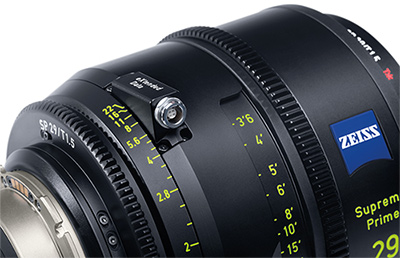 First the basics: the Supremes (as we expect them to be known informally) are large image circle prime lenses (46.2mm diameter), ranging from 15-200mm, and sporting consistent T1.5 maximum apertures from 18-135mm. They feature interchangeable ARRI PL, ARRI LPL, and Canon EF mounts and support the eXtended Data metadata protocol, which debuted on ZEISS's CP.3 line. All but the widest and longest lenses use a common 95mm front, with the others coming in at 114mm. The housing uses design elements from other high-end ZEISS lenses, such as the Master Primes, with a rotating collar revealing distance marks (calibrated, of course, and fully interchangeable between imperial and metric units). However, rather than a (sometimes) bulky cam-and-follower mechanism, the Supremes focus using a square-thread helical for maximum mechanical and thermal consistency. They also feature a unique, non-linear iris throw, first seen on the ZEISS Master Anamorphics, allowing for more granularity in setting the widest stops, or fractions thereof. This is sure to be a boon for ACs in the brave new world of full format, where VistaVision-sized sensors and vanishingly shallow depth-of-field are the new normal.
First the basics: the Supremes (as we expect them to be known informally) are large image circle prime lenses (46.2mm diameter), ranging from 15-200mm, and sporting consistent T1.5 maximum apertures from 18-135mm. They feature interchangeable ARRI PL, ARRI LPL, and Canon EF mounts and support the eXtended Data metadata protocol, which debuted on ZEISS's CP.3 line. All but the widest and longest lenses use a common 95mm front, with the others coming in at 114mm. The housing uses design elements from other high-end ZEISS lenses, such as the Master Primes, with a rotating collar revealing distance marks (calibrated, of course, and fully interchangeable between imperial and metric units). However, rather than a (sometimes) bulky cam-and-follower mechanism, the Supremes focus using a square-thread helical for maximum mechanical and thermal consistency. They also feature a unique, non-linear iris throw, first seen on the ZEISS Master Anamorphics, allowing for more granularity in setting the widest stops, or fractions thereof. This is sure to be a boon for ACs in the brave new world of full format, where VistaVision-sized sensors and vanishingly shallow depth-of-field are the new normal.
 Photo by Kozo Takahashi
Photo by Kozo Takahashi
ZEISS Supreme Primes Technical Details
ZEISS is helping DPs translate the fields of view of familiar Super35 focal lengths, from their widely-used Ultra Prime series, to their new full format equivalents. See below for a handy chart showing how, on the ALEXA LF, to convert from standard Super35 to the equivalent field of view on the larger sensor, and then finally to the closest available Supreme focal length.
| Ultra Prime Focal Length (on ALEXA Super35) | ALEXA LF Full Format Equiv. Focal Length | ZEISS Supreme Prime (closest match) |
| 14 mm | 21.4 mm | 21 mm |
| 16 mm | 24.5 mm | 25 mm |
| 18 mm | 27.5 mm | 29 mm |
| 24 mm | 36.7 mm | 35 mm |
| 32 mm | 49 mm | 50 mm |
| 40 mm | 61.2 mm | 65 mm |
| 50 mm | 76.5 mm | 85 mm |
| 65 mm | 99.5 mm | 100 mm |
| 85 mm | 130 mm | 135 mm |
| 100 mm | 153 mm | 150 mm |
| 135 mm | 206.5 mm | 200 mm |
ZEISS is similarly supplying a rough rule-of-thumb for depth of field: when using a given Supreme Prime wide open at T1.5—on a full format sensor—expect the depth-of-field to be similar to a T1.0 aperture on a Super35 sensor. The reason for this is that, in order to match fields of view, and therefore apparent subject size, between a Super35 and full format sensor, a longer lens is required to achieve the same framing on the full format camera. So, consulting the chart above, where one might use a 50mm T2 Ultra Prime on a Super35 camera, an 85mm Supreme Prime will provide the same framing, or angle of view, on a full format camera. But when focussed at the same distance, and set to the same T-stop, T2 in this case, the 85mm will provide a noticeably more blurred background resulting from the longer focal length being used.
Another boon for ACs, seconds, and operators alike is the size and weight of these new lenses: astonishingly, less than 4 pounds avoirdupois from 21-100mm, with many under 3.5 lbs., and the 50mm a mere 2.7 lbs. This makes the Supremes an easy choice when performing extensive handheld shots or for use on drones, gimbals, and other applications where every ounce counts.
 Photo from "Test Shoot", DP Maher Maleh
Photo from "Test Shoot", DP Maher Maleh
As with the CP.3 XD series from ZEISS, the Supremes come standard with the new eXtended Data metadata protocol, which incorporates Cooke's /i technology while providing additional metadata, such as shading/vignetting information, which can be recorded frame-by-frame using Ambient's Master Lockit Plus or on RED's DSMC2 cameras (with updated firmware).
We'll have to wait for Cine Gear in early June (exhibits open June 1-2) for a closer look and extended hands-on time with this exciting new series of lenses from ZEISS – and only from ZEISS, incidentally: the Supremes are the first modern, high-end ZEISS cinema primes to carry solely their own branding. Regarding the look, we know from previous discussions that the aim was to depart from the almost "clinical" sharpness of, for example, the Master Primes and embrace a more organic fingerprint for the Supremes. We'd look for these lenses to be more forgiving than one might expect, while being no less sharp than their elder ZEISS siblings, with special attention being paid to handling all-important skin tones. Known for the neutrality of their T* coatings, we'd expect any new ZEISS lenses to be free of obvious casts but look for the Supremes to perhaps lean to the warmer/richer side of neutral rather than the cooler.
All in all, the new ZEISS Supreme Primes, or simply the Supremes, if you will, look like they could be the beginning of a beautiful friendship between full format cameras and lenses.
For more (much, much more) on the Supremes, read the latest special report in the Film and Digital Times, available on their website as a free PDF download.













